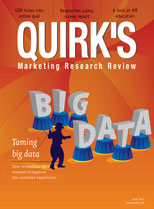Editor's note: Jennifer Karsh is founder and president of Axen Research, Los Angeles. She can be reached at jennifer@axenresearch.com. This article appeared in the June 24, 2013, edition of Quirk's e-newsletter.
We've all been there. You're testing a new product and the focus group participants are loving it. They are telling you that this new product will change their lives and they can't wait until it hits the market. The participants are practically pulling out their wallets as you conclude the group and say goodbye. You walk to the back room where the client team members are smiling ear-to-ear and ready to high-five you. You enjoy the temporary hero status.
As someone who works in qualitative research, you know that days like this are the exception rather than the rule. But whether the future of a product you're examining is in the marketplace or the bottom of a file drawer, the feedback from focus groups is always relevant and it's our job as researchers to present the news - good or (seemingly) bad - in a way that helps complete the brand picture. Sometimes, that means focusing on the negative.
While bad news does not feel as fulfilling as good news, it is actually more useful. Bad news can save you or your client from making a giant and costly mistake and can highlight the pathway to improving a product, streamlining a process or generally improving a concept.
Negative space
Those familiar with art might be familiar with a concept called negative space. Negative space describes the space around and between the subject of an image. The negative is used as a neutral or contrasting background to draw attention to the main subject (the positive space).
This concept works not just in art and design but also in strategy and analysis. By looking at the negative data surrounding a given product or brand, we can glean the shape of a well-defined image or problem. Applied to research, we can get the clearest view of the positive through seeing and assessing the negative. We call this method reverse insighting.
Add value
As qualitative researchers and analysts, we add value to the research process by helping define the problem that needs to be solved. For example, I was recently testing a new package design for a health and beauty client. The objective of the project was to understand whether this packaging would resonate with an audience that was older than the brand's typical target. We tested the package with a full range of demographics. Turns out, the new packaging not only alienated the older audience, it also was an utter failure among the brand's current consumers. However, as we worked through all of the negative data and feedback, we discovered a very positive theme.
In this case, we used reverse insighting to assess everything that did not work about the packaging (the negative space) to optimize everything that was working about the packaging (the positive space). By assessing the product in this way, we gave our client a big-picture view of their packaging triumphs and hurdles. While this was not the message they initially wanted to hear, the way we delivered the news was key not only to accepting the news but relishing it. The challenge is not the negative information itself but the delivery of that news. After all, it's not what you say but how you say it.
Describe and define
So how do you make lemons out of lemonade? How do you give a spoonful of sugar to help the medicine go down? In the words of the philosopher and psychologist John Dewey, "A problem well put is half solved." In assessing a concept or product or innovating, you must first clearly describe and define the problem. The emerging practice of design thinking in business is based on this very important ideal. Working with your client team to create a project brief with a clearly defined problem to solve will allow you to set the stage for clear and meaningful insights.
Once the interviews have been completed and the findings have been collected, it's important to process or analyze the data in an artful manner - literally. I recommend drawing a picture of the subject of your research and sketching out where the positive and negative feedback fits in. By processing your findings using text and visuals, you will gain a much more in-depth understanding of the insights and how they relate to each other.
Laid the foundation
When it comes to delivering "bad" research news, you've now laid the foundation for providing a clear picture of the objectives, problems, processes and solutions. This protocol will allow you to offer your team the perspective they want and need to move forward. By showing the full picture of your research - the negative and positive space - and the strategy and solutions that surround that picture, you are giving your audience the most priceless research insight of all: clarity.
